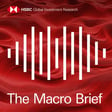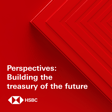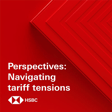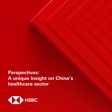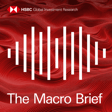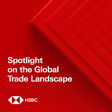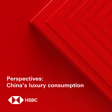Become a Creator today!Start creating today - Share your story with the world!
Start for free
00:00:00
00:00:01

Asia and Europe outlooks, India’s challenges, LatAm demographics - HSBC Global Research
Frederic Neumann assesses Asia’s recovery, Pranjul Bhandari looks at the challenges facing India, Simon Wells analyses the European rebound and Herald van der Linde introduces our new report on LatAm demographics. Disclaimer
To stay connected and to access free to view reports and videos from HSBC Global Research click here
Hosted on Acast. See acast.com/privacy for more information.
Transcript
Introduction to HSBC Global Viewpoint
00:00:00
Speaker
This is HSBC Global Viewpoint, your window into the thinking, trends and issues shaping global banking and markets.
00:00:09
Speaker
Join us as we hear from industry leaders and HSBC experts on the latest insights and opportunities for your business.
00:00:17
Speaker
Thank you for listening.
Macro Viewpoint with Piers Butler & Aileen Van Dyne
00:00:25
Speaker
Hello and welcome to the macro viewpoint from HSBC Global Research, our weekly podcast featuring the views of leading HSBC analysts on the outlook for the global economy and markets.
00:00:36
Speaker
I'm Piers Butler and I'm joined by Aileen Van Dyne.
00:00:39
Speaker
Hi, Piers.
00:00:40
Speaker
Coming up on this week's program, we look at what to expect from Asia's recovery with Fred Newman, co-head of Asian Economics Research.
Asia's Economic Recovery & Challenges
00:00:49
Speaker
India has been ravaged by a second wave of infections this year.
00:00:52
Speaker
We consider the outlook for the country with Pranjal Bhandari, Chief India Economist.
00:00:57
Speaker
We asked Simon Wells, chief European economist, whether the region's economies could emerge from the slump with economic growth running above pre-pandemic trends.
00:01:08
Speaker
And Harold van der Linde gives us a quick overview of our new report on Latin America's demographics.
00:01:14
Speaker
This podcast was recorded on Thursday, the 1st of July 2021.
00:01:19
Speaker
Our full disclosures and disclaimers can be found in the link attached to this podcast.
00:01:29
Speaker
We kick things off this week in Asia, where the economic recovery across the region has been uneven in recent months.
00:01:35
Speaker
Fred Newman, co-head of Asian Economic Research, has just published his latest quarterly report, and he joins us now from Hong Kong.
00:01:41
Speaker
Fred, welcome to the podcast.
00:01:43
Speaker
Thank you for having me.
00:01:44
Speaker
So, Fred, we've seen a resurgence of the virus in Asia.
00:01:47
Speaker
How is that impacting your second half outlook for the region?
00:01:50
Speaker
So we've really had a few tough months in Asia.
00:01:53
Speaker
We saw huge numbers of cases in India, of course, which took a massive human toll above all, but also had economic consequences.
00:02:03
Speaker
And the concerns are now shifting to ASEAN, where there are pockets where we see rising cases.
00:02:09
Speaker
And so when we think about the second half of the year, there will be a recovery.
00:02:14
Speaker
But in pockets, it's going to be halting because of the ongoing risk
00:02:19
Speaker
from the virus and also the need to maintain certain restrictions, travel restrictions in particular, which really weigh on economic activity.
00:02:31
Speaker
So it is a story about improvement, about a recovery, but not perhaps as fast just yet as we see in some of the Western economies, for example.
00:02:40
Speaker
Obviously, that recovery has been driven largely by China.
00:02:43
Speaker
What's your outlook for that economy in the near term?
00:02:46
Speaker
So China has had a very strong run over the past year.
00:02:50
Speaker
It was primarily driven by the construction and investment sector.
00:02:55
Speaker
There are now signs though that that is cooling because the Chinese government has started to tighten the reins a little bit on the construction and housing sector in particular.
00:03:06
Speaker
And we see the credit impulse, for example, turn negative.
00:03:10
Speaker
Now, what this means for the Chinese economy is that the real estate construction sector, property sector, will likely slow, and that's a headwind for growth.
00:03:20
Speaker
Now, there are some positives here, and that is increasing manufacturing investment.
00:03:24
Speaker
So China is in the midst of a capex boom.
00:03:27
Speaker
which is incidentally something we expect for the rest of the region.
00:03:31
Speaker
So it's steady as she goes in China, but there's a shift really in the drivers away from heavy construction towards more capex type of activity.
Inflation & Central Bank Strategies
00:03:41
Speaker
One of the things that has markets concerned is a rise in inflation.
00:03:45
Speaker
Do you think central banks in Asia are going to need to tighten?
00:03:49
Speaker
Not anytime soon.
00:03:50
Speaker
So for virtually all of Asia, India is a little bit of an exception, but we see very few sustained consumer price inflation pressures coming through.
00:04:01
Speaker
There is certainly a rise in producer prices, and we know from surveys that producers are seeing rising cost pressures.
00:04:09
Speaker
But these are not really being passed on to consumers in Asia.
00:04:13
Speaker
And that has to do with the fact that we see a very gradual consumer spending recovery in Asia.
00:04:18
Speaker
So there's no pricing power for companies.
00:04:21
Speaker
And that means for central banks that they can really take the sweet time before they start tightening.
00:04:26
Speaker
So, you know, the big tightening wave, if you will, the first rate hike is only going to come through over the second half of 2022.
00:04:34
Speaker
There's one exception, interestingly, and that's the Bank of Korea, which we expect to hike this year, later this year, but not so much out of inflation concerns, but because of concerns of rising asset prices, real estate prices.
00:04:48
Speaker
So a slightly different set of challenges there.
00:04:51
Speaker
We've been reading a lot about supply chain disruption.
00:04:55
Speaker
How serious is that?
00:04:56
Speaker
And is there some light at the end of the tunnel?
00:04:59
Speaker
Well, we are seeing still enormous amounts of backlogs in terms of shipments.
00:05:03
Speaker
We just had the disruption in the Yantai port in southern China, which in terms of the magnitude of the disruption was about twice the disruption at the Suez Canal closure delivered.
00:05:17
Speaker
So this is a port in southern China where container throughput was disrupted by 50 percent in the month of June, partly because of COVID-19 restrictions that were imposed.
00:05:28
Speaker
Fortunately, that's coming out now, so that should remove some bottlenecks.
00:05:34
Speaker
But the ripples will be felt for another three or four months.
00:05:37
Speaker
There are other concerns emerging.
00:05:40
Speaker
As I said, in Southeast Asia, there are now pockets of rising COVID-19 cases.
00:05:45
Speaker
and there could now be some disruptions coming through in Vietnam or in Malaysia, for example, in terms of shipments.
00:05:52
Speaker
It's brought a logistics issue more than the production issues.
00:05:55
Speaker
When we talk about supply chain constraints, it's a transportation issue at the moment, perhaps more than pure production.
00:06:03
Speaker
But we do think, by and large, it will abate over the second half of the year.
Investment Boom in Asia
00:06:08
Speaker
Finally, what do you see as the next big growth driver?
00:06:11
Speaker
So it's not going to be a consumer-led recovery by and large, but it's going to be a CapEx-led recovery.
00:06:18
Speaker
So for us, the next big thing for Asia is a CapEx boom.
00:06:21
Speaker
And what we mean by this is that companies will expand manufacturing investments already happening in mainland China to some extent.
00:06:30
Speaker
We think that will accelerate, but it's also going to happen across the rest of the region.
00:06:34
Speaker
And the supply chain issues I just mentioned also revealed that we actually underinvested in CapEx in recent years, the capacity constraints.
00:06:45
Speaker
And now as we kind of tiptoe ourselves towards the exit of the pandemic, we think that corporations will dust off very aggressive spending plans on CapEx.
00:06:56
Speaker
And that really is going to be sort of over next year or so what drives Asia and gets Asia to roar back after we get rid of this virus.
00:07:06
Speaker
Fred, thanks very much for your time.
00:07:09
Speaker
Thank you.
00:07:13
Speaker
Fred mentioned India there and the huge second wave of the infection seen in the country this year.
00:07:19
Speaker
And although cases have fallen recently, there is plenty to be concerned about as the economy recovers.
00:07:26
Speaker
Pranjal Bhandari is our chief India economist and she joins us now.
India's Recovery & Economic Outlook
00:07:31
Speaker
Pranjal, how bad was the impact of the second pandemic wave on the economy?
00:07:36
Speaker
Yes, so you know the good news first, the second wave seems to be receding.
00:07:40
Speaker
Just about a month and a half ago, India was seeing 400,000 new cases per day, and that's down to 30,000 new cases per day right now.
00:07:49
Speaker
Vaccination rates have also picked up quickly.
00:07:52
Speaker
Overall, the direct cost of the lockdowns that we've seen in 2021 is only likely to be about half of the direct cost that we'd seen last year in the first wave.
00:08:02
Speaker
The bad news comes when we think about the indirect cost, which I worry will be higher this time around, led by the uncertainties that are there in the system.
00:08:11
Speaker
For example, the emergence of a third wave in the next couple of weeks.
00:08:15
Speaker
And I think these uncertainties would keep the pent up demand pretty low.
00:08:21
Speaker
In fact, our senses that the pent up demand driven growth in September will perhaps be about half of the growth coming out of the first wave.
00:08:30
Speaker
Overall, we think GDP will grow 8% in FI22, which is the current fiscal year.
00:08:36
Speaker
This is lower than consensus expectations of 9.3%.
00:08:41
Speaker
But we do think there's going to be an improvement from an uncertainty-led sequential contraction in the first half to a vaccination-led expansion in the second half.
00:08:50
Speaker
So which sectors will lead the rebound?
00:08:53
Speaker
As the vaccination rates rise, our senses that the urban affluent may want to begin purchasing more services than goods, but the pace of vaccination has been slower in rural India.
00:09:05
Speaker
I think rural Indians won't go to services that quickly.
00:09:08
Speaker
They will focus on goods, particularly those that make them secure.
00:09:12
Speaker
Thankfully for them, agricultural wages have held on pretty well through the pandemic because of good monsoon rains.
00:09:18
Speaker
But moving away from consumption,
00:09:20
Speaker
There are a lot of expectations that the CAPEX cycle will be picking up soon, buoyed by the low interest rate environment and also a favorable global backdrop.
00:09:30
Speaker
Our sense is that even if this provides an initial push, only effective reforms will lead to a sustainable rise in the CAPEX cycle.
00:09:39
Speaker
You know, we're watching out for four reforms in particular.
00:09:42
Speaker
Number one, strengthening the insolvency and bankruptcy code.
00:09:45
Speaker
Number two, sustaining social welfare spending.
00:09:48
Speaker
Number three, getting the disinvestment drive of the government done quickly so it can get more revenues quickly.
00:09:55
Speaker
And number four, focusing on export promotion and moving away from import substitution.
00:10:00
Speaker
These are the four reforms that we are focusing on.
00:10:03
Speaker
And what's the latest on inflation?
00:10:06
Speaker
Yeah, inflation has been high.
00:10:07
Speaker
You know, it's been running higher than RBI's 4% target for the last 20 months.
00:10:12
Speaker
And in May, it even overshot the upper tolerance limit of 6%.
00:10:16
Speaker
And, you know, it may stay in the 6% range for the next couple of months.
00:10:21
Speaker
As some of the logistics led disruptions abate, some pressure could come off.
00:10:26
Speaker
But, you know, we are worried that new pressures could come back on in the second half of the year.
00:10:30
Speaker
You know, things like cost push inflation, higher services demand leading to services inflation.
00:10:36
Speaker
So overall, we remain worried about inflation.
00:10:39
Speaker
So given that backdrop, how do you expect the central bank to react to?
00:10:44
Speaker
Yes, you know, in the next meeting, which is in August, we think the commentary will turn a little more hawkish around inflation worries.
00:10:51
Speaker
And then starting in the December quarter, we think the actual gradual normalization of monetary policy will begin.
00:10:58
Speaker
You know, three steps to start with gradually draining out of the surplus liquidity, raising the reverse repo rate, which is currently at 3.35%.
00:11:10
Speaker
and eventually changing the stance from accommodative to neutral, perhaps sometime in early 2022.
00:11:16
Speaker
So these are the steps we think the RBI will start with.
00:11:20
Speaker
Over time, it may also want to increase the benchmark repo rate, which is currently at 4%.
00:11:26
Speaker
We think it'll happen in the second half of 2022.
00:11:29
Speaker
We're penciling in a 50 bps rise in the repo rate in the second half of 2022, and more 50 bps hike in the repo rate in early 2023.
00:11:39
Speaker
Pranjal, that's a great summary.
00:11:41
Speaker
Thanks very much.
00:11:43
Speaker
Great to be here.
00:11:43
Speaker
Thank you.
00:11:47
Speaker
Let's switch to Europe now, where COVID-19 restrictions are gradually being
Europe's Economic Landscape & Risks
00:11:51
Speaker
eased.
00:11:51
Speaker
And with the recovery gathering pace, some forecasts are implying that economies are set to emerge from the pandemic in good health.
00:11:58
Speaker
Let's get the view of our chief European economist, Simon Wells.
00:12:02
Speaker
So, Simon, let's kick off with all these headlines on COVID-19 and its latest Delta variant.
00:12:08
Speaker
How big a risk is that to the outlook?
00:12:10
Speaker
It's certainly the case that Europe's economic recovery has gathered pace.
00:12:15
Speaker
That reflects the unlocking of economies and the advancement of the vaccination programmes.
00:12:20
Speaker
But yes, there is a risk from the Delta variant.
00:12:24
Speaker
Cases are on the rise in the UK and almost all of those cases are Delta variant cases.
00:12:29
Speaker
And we're starting to see incidents of Delta variant pick up on the continent too.
00:12:35
Speaker
That's perhaps a bit more of a concern there because in some countries in particular, vaccination rates among the elderly are a lot lower than
00:12:43
Speaker
than they are in the UK.
00:12:45
Speaker
And so far in the UK, although we've seen cases rise, we haven't seen hospitalisations rise to anything like the same extent.
00:12:53
Speaker
So COVID is the big downside risk.
00:12:56
Speaker
There is still upside risks as well, not least from the huge amount of savings that households accumulated through last year.
00:13:03
Speaker
If those were spent quickly, growth could still surprise us on the upside.
00:13:07
Speaker
So can you sum up what you've done to your forecasts?
00:13:10
Speaker
We've raised our Eurozone growth forecast from 3.6% to 4.4% for this year and kept next year unchanged at 4%.
00:13:18
Speaker
Whereas for the UK, we've nudged up further.
00:13:21
Speaker
We now see 7.1% growth this year, though, of course, the UK had a deeper contraction in 2020 and 5.1% growth in the UK in 2022.
00:13:34
Speaker
Now, Simon, I was struck by something you said in your latest economic quarterly, and I'll quote, some forecasts suggest the global pandemic could be good for growth.
00:13:44
Speaker
Can you shed some light on this?
00:13:45
Speaker
Yes, absolutely.
00:13:46
Speaker
So what typically happens after a recession is that economies never quite get back to the trajectory that they were on before that recession.
00:13:57
Speaker
There is a degree of permanent economic scarring as a result of the downturn.
00:14:03
Speaker
Now, despite a very deep recession last year for the eurozone, we assume that this lost output now by the end of 2022 is going to be very small, around 0.4% of GDP lost.
00:14:14
Speaker
Now, that means if some upside risks crystallise, we could end up above the pre-pandemic trajectory.
00:14:20
Speaker
And indeed, the ECB's mild scenario from its June forecast do indeed put GDP above the pre-pandemic trend in 2023.
00:14:31
Speaker
Now, how can this be?
00:14:32
Speaker
Well, for one thing, we've had loose fiscal policy, loose monetary policy.
00:14:38
Speaker
And in Europe, the EU has its next generation EU fund, which is going to raise investment.
00:14:44
Speaker
And the recovery and resilient plans associated with that should also drive some reform of labour markets and tax systems.
00:14:52
Speaker
So over the longer term, this investment could raise capital levels and capital deepening in the economy.
00:14:59
Speaker
And we could also see improved productivity from more flexible labour markets.
00:15:03
Speaker
So in that sense, it is possible for Europe to build back better.
00:15:08
Speaker
But we shouldn't forget some of these structural headwinds that challenge Europe in terms of political situation,
00:15:14
Speaker
aging populations and rather rigid labor markets.
00:15:19
Speaker
It's possible that it could happen, but there are still several obstacles.
00:15:23
Speaker
Now, I can't let you go without talking about inflation.
00:15:27
Speaker
And it's fair to say that a lot of commentators express a lot of concerns about the resurgence of inflation.
00:15:33
Speaker
We think it's more of a temporary risk.
00:15:35
Speaker
Why is that?
00:15:36
Speaker
Well, a lot of the pressures that we're seeing should be one-time cost shocks.
00:15:40
Speaker
So yes, supply bottlenecks, rises in shipping costs and so on have produced some eye-watering rises in survey measures of input and output costs.
00:15:50
Speaker
But as these bottlenecks eventually ease, we should start to see this unwind.
00:15:57
Speaker
And within a year, these effects should drop out of the annual inflation rate.
00:16:02
Speaker
So we should see it come back a bit.
00:16:03
Speaker
Of course, there is a risk that this feeds through into expectations and it feeds through into higher pay deals.
00:16:09
Speaker
But for the eurozone, we're really seeing no evidence of that happening.
00:16:14
Speaker
That said, our faster growth forecasts do mean a little bit less slack in the economy in 2022.
00:16:20
Speaker
So we have raised inflation by about 0.2 for next year on average.
00:16:25
Speaker
But in the eurozone, that still means well below the ECB's target.
00:16:28
Speaker
So the ECB, we think, can keep policy loose.
00:16:32
Speaker
For the UK, it's a slightly different story.
00:16:35
Speaker
There seems to be a bit more evidence of labour market tightness.
00:16:38
Speaker
We now see UK inflation a little above the Bank of England's target next year.
00:16:42
Speaker
And just to finish, how do you think the Bank of England will respond to that?
00:16:45
Speaker
Well, we now think it's going to respond with a tightening cycle.
00:16:48
Speaker
We forecast the first UK rate rise in May of next year, followed by another one in November of next year, taking bank rate back to half a percent by the end of 2022.
00:17:00
Speaker
And we forecast at least one further rate rise in 2023 as well.
00:17:05
Speaker
Simon, thank you very much.
00:17:06
Speaker
Thank you.
Opportunities in Latin America
00:17:10
Speaker
Before we end, we've just got time to tell you about the latest in our series of reports on global demographics, this time focusing on Latin America.
00:17:20
Speaker
Harold van der Linde is one of our regional coordinators on the demographics theme, and he's here to give us a quick overview of the report.
00:17:30
Speaker
So Harold, what are the key issues in Latin?
00:17:33
Speaker
The issue with Latin America is that it's at its peak of what we call the first demographic dividend.
00:17:38
Speaker
That is the number of working people in an economy.
00:17:42
Speaker
that is going to decline over the next couple of years so the dividends typically associated with this are going to come down as well.
00:17:49
Speaker
It's not good for growth.
00:17:50
Speaker
However, there's also a second demographic dividend.
00:17:53
Speaker
As societies age and therefore also less people work, very often the societies can accumulate wealth.
00:18:00
Speaker
There are all sorts of wealth effects that can play a major role.
00:18:03
Speaker
And the real challenges and the opportunities for Latin America lie right here to capture the savings and refund them into the rest of the economy and investments.
00:18:16
Speaker
The question is can these countries do that?
00:18:18
Speaker
In the report we look at this in considerable detail.
00:18:22
Speaker
More details on healthcare, education, trends, data, all of that is available in the report.
00:18:29
Speaker
It's available on the research website.
00:18:31
Speaker
Thank you.
Conclusion & Further Resources
00:18:33
Speaker
That brings us to the end of another edition of the Macro Viewpoint.
00:18:36
Speaker
Thank you to our guests, Fran Newman, Pranjal Bhandari, Simon Wells, and Harold van der Linde.
00:18:41
Speaker
From peers and me, thanks very much for listening.
00:18:44
Speaker
We'll be back again next week.
00:18:53
Speaker
Thank you for listening today.
00:18:55
Speaker
This has been HSBC Global Viewpoint, Banking and Markets.
00:18:59
Speaker
For more information about anything you heard in this podcast or to learn about HSBC's global services and offerings, please visit gbm.hsbc.com.
